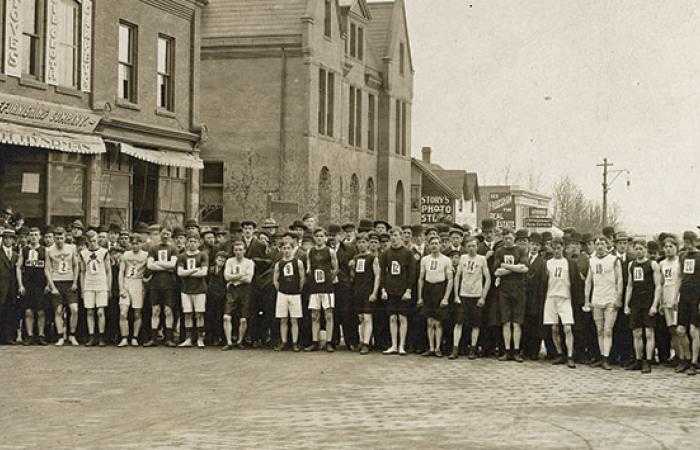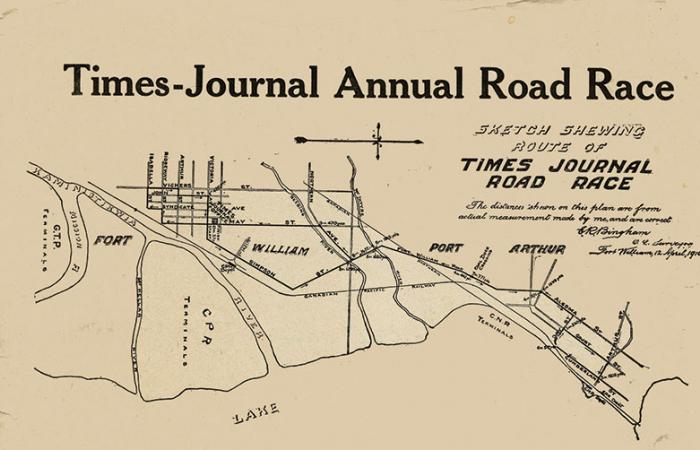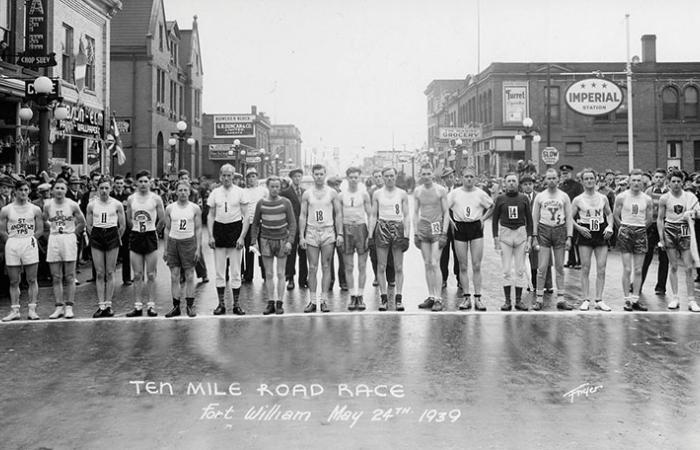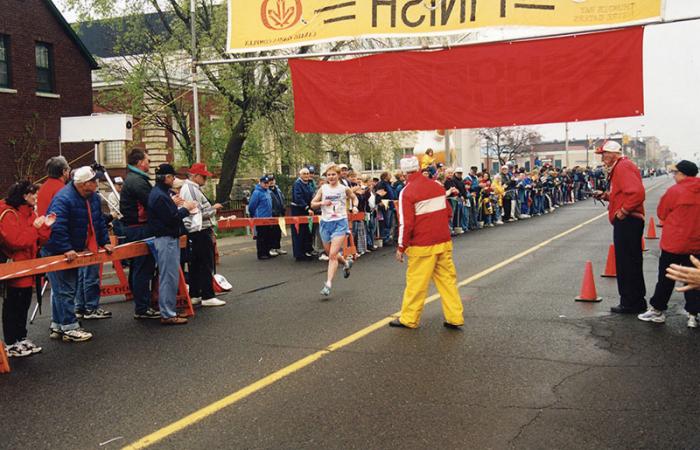As a transplanted Torontonian who has lived in Thunder Bay for almost thirty years, one of the things which continues to amaze me is that no matter what the weather the people of this great city can be found outside participating in their favourite sport. Throughout the winter, as I was driving through the streets in my warm car, complete with heated seats, I would often see some of the bravest of the brave, dodging snow banks as they pursued their passion for running.
Not only do they brave the elements individually they also do so in a group. Since 1981 the Thunder Bay Metre Eaters have sponsored a race held in late February. Originally called the Groundhog Run, it is known today as the Run for the Meatball. Taking off from Charry Park bundled up in their hats, mitts and scarves the group undertakes a 5 km race that culminates in a spaghetti and meatball lunch at the Columbus Centre. People who run in the winter must obviously maintain a great sense of humour.
As the weather starts to warm up, more and more runners can be seen taking to the streets of Thunder Bay with many of them beginning their training for a historic race which can trace its roots back over a century. As runners take to the starting line for the 2016 Firefighters Ten Mile Road Race this coming May long weekend they will be carrying on a tradition that began on May 24th, 1910 when twenty-one participants lined up along May Street to take off for the start of the race which was originally sponsored by the Fort William Daily Times-Journal.
Promotions for the 1910 race noted that the top three finishers would receive ‘handsome trophies’ which would become the property of the winner following the race. The 1st, 2nd and 3rd place trophies were placed on display in the window of McGimsie & Martin’s store on Simpson Street. The public was encouraged to venture downtown to view them in advance of what was being billed as the biggest sporting event of the year.
Prior to the start of the inaugural race local physician, Dr. R.J. Manion was on hand to ‘test the bellows’ of every runner to make sure they were fit for the challenge, with two would-be participants being advised not to run. The race was started at 10:00 by Fred Mitchell, using a nervous Police Chief William Dodd’s actual gun. The 21 runners, who had each paid a 50 cent entry fee, took off from the starting line in front of the Times-Journal building which is today home to Victoria’s Cupboard.
The newspaper accounts of the day of the race stated that neither city had ever seen anything like it. Thousands cheered on the runners as they made their way along the course. The fact that the race wound its way through the streets of Fort William and Port Arthur was the perfect recipe to fuel the sports rivalry that existed between the twin cities. When the crowd was made aware of the fact that it was a Port Arthur runner who was in the lead, many in that city made their way over to Fort William in automobiles, on street cars and by rigs to witness the finish. They were not disappointed as it was John Edwards of Port Arthur’s Maple Leaf A.A.A., who maintained his lead to win the inaugural race in a time of 57 minutes flat. The trophy that was presented to Edwards back in 1910 is currently on display at the Northwestern Ontario Sports Hall of Fame.
The second year of the race included participants from outside the region. In 1911 the famous Cree runner from Norway House First Nation, Joe Keeper, finished the race in a time of 54:50, a record which stood until 1936. When Keeper returned in 1913 he did so as an Olympian, having finished 4th at the 1912 Stockholm Games in the 10,000 metre run, the best ever by a Canadian. A reported 20,000 spectators turned out to see him win the Times-Journal 10 Mile race for the second time.
The race was cancelled from 1915 to 1919 due to World War I and started up again in 1920 and continued throughout the 1930s, until world affairs once again intervened with World War II forcing the cancellation of the event following the 1939 race. In 1949 efforts were made to revive the race by Branch 6 of the Royal Canadian Legion. Although somewhat unsuccessful in their first attempt, they were able to bring it back to life in the 1960s, going on to sponsor it until 1989. Since that time other sponsors have taken over the race at various times throughout its history including Lakehead University, Bell Canada, Shoppers Drug Mart and the current race sponsor the Thunder Bay Professional Fire Fighters Association and total sponsor Half-Way Motors Nissan.
Over the years there have been some great stories associated with the race including one involving multiple-winner Arjan Gelling. His first victory came in 1963 as a sixteen year old Lakeview High School student. He was ahead of the pack again in 1965 and 1966 and crossed the finish line in 1967 in a record time of 52:06. In 2013, at the age of 66, fifty years after winning his first race, he returned home from Nanaimo, BC, with a goal of finishing the race in a symbolic time of 63:50. He crossed the finish line in a time of 63:48 establishing a record for his age group and earning the admiration of his fellow runners and the scores of people who lined the streets. His accomplishment was that much more significant given that just months prior to the race he had undergone treatments for cancer which had limited his pre-race training to walking.
The 10-Miler, as it has come to be known, has evolved from a competition for elite runners to one which welcomes people of all abilities and ages with those original 21 entrants growing to as many as 1,000. Congratulations to the dedicated group of volunteers, participants, sponsors and cheering fans who have kept the ten-mile road race, and all of the running events held throughout our community, alive and well. And to all of those hearty souls who lace up their runners each and every day, in rain, sleet and snow, to pursue your passion, keep on trekking and know that you have the admiration of all of us less hearty souls.











